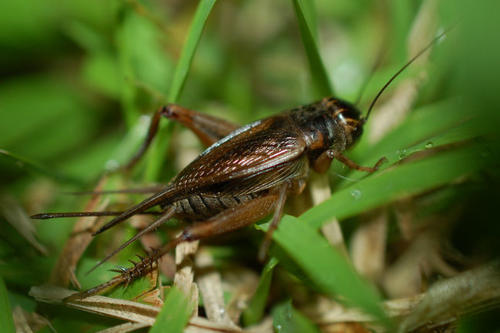
In the past several decades, a mutation has spread among male Pacific field crickets (Teleogryllus oceanicus) in Hawaii that leads to wing structures that are unable to produce the crickets' signature chirping. While the mutation has kept crickets safe from a parasitic fly that uses cricket song to find its hosts, it also means the crickets are unable to sing to attract females. The fly’s larvae burrow into the cricket, eating it from the inside out, and emerge once the cricket dies.
“However, we noticed a relatively stable balance in the male cricket population between those that could sing and those that could not,” said Jessie Tanner, who led the study as a doctoral student in the College of Biological Sciences. “We wanted to better understand how this balance between male crickets with the mutation and without is struck in the real world — considering those that can sing attract not only potential mates but also deadly parasites.”
To do that, researchers need to be able to examine the offspring of female crickets. They collected and allowed wild, female Pacific field crickets to lay eggs in a controlled environment. The hatched crickets were raised to adulthood and allowed to breed, creating a new generation.
“Through this method we were able to see evidence of what the females had been doing — and who they had mated with in the wild — by examining the offspring they produced, without ever seeing what had really occurred in the field," said Marlene Zuk, co-author of the study and a professor in the College of Biological Sciences.
The study, published in the journal Evolution, found:
- singing males outcompeted silent males in terms of reproductive success;
- most females had mated more than once and the offspring of most wild females were fathered by primarily or exclusively singing males;
- wild females were relatively unlikely to carry the mutation themselves.
“These findings help us understand why singing crickets remain common in Hawaii even though singing likely results in parasitization and death,” said Tanner. “This is one of relatively few examples of rapid, contemporary trait loss. It’s an excellent opportunity to study what happens when two major drivers of evolutionary change act in conflict.”
Further research is needed to investigate why females that carried copies of the mutation in their X chromosomes seemed more likely to have offspring fathered by mutant males than females that did not carry the mutation.
“If female behavior is affected by the same mutation that affects male wings, that may help explain what caused mutant male crickets to spread through the population,” said Tanner.
Funding was provided by the University of Minnesota Department of Ecology, Evolution, and Behavior; Theodore J. Cohn Research Grant from the Orthopterists’ Society; National Science Foundation Graduate Research Fellowship under Grant No. 00039202; and Ford Foundation Predoctoral Fellowship.
About the College of Biological Sciences
The College of Biological Sciences at the University of Minnesota is one of two colleges in the United States dedicated to the biological sciences with undergraduate majors and graduate programs that cover the spectrum of life from molecules to ecosystems. Learn more at cbs.umn.edu.
- Categories:
- Science and Technology





